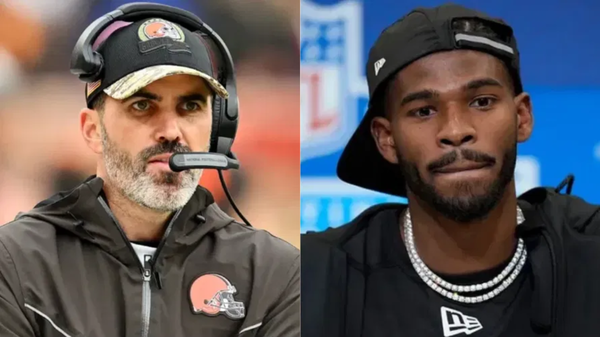
via Imago
Image Credits: Imago

via Imago
Image Credits: Imago
Despite a training camp where Shedeur Sanders completed a stellar 70% of his passes in team drills, with five touchdowns and 0 INTs, he found himself as the emergency QB3. The Browns‘ QB drama this preseason wasn’t about arm talent or athleticism; it was a clash between a coach’s rigid vision and a rookie’s ingrained instincts. And the result has reshaped the entire depth chart.
As NFL Films guru Greg Cosell explained, the decision to keep Dillon Gabriel over Sanders as QB2: “He fits Kevin Stefanski…Kevin Stefanski REALLY liked him coming out because of the way in which he plays,” Cosell noted, cutting to the heart of the matter. “Gabriel is purely a timing rhythm player. Stylistically, you’d say he’s similar to Tua Tagovailoa.” The numbers prove it:
He operates with a Time to Throw of 2.72 seconds (according to Mina Kimes), a stark contrast to Sanders’ 3.96 seconds. That fraction of a second is the difference between a rhythm throw and a potential sack, and it’s everything in this system. This is the entire blueprint for the Kevin Stefanski offense condensed into one evaluation.
ADVERTISEMENT
Article continues below this ad
“He hits the back foot, the ball comes out, and that’s the way Kevin Stefanski sees his offense,” Cosell continued. “He sees Gabriel as the kind of Quarterback that can efficiently run what he wants to do, it’s all about timing and rhythm, and that’s the way in which Gabriel plays.”
Poll of the day
Poll 1 of 5
AD
“Kevin Stefanski REALLY liked him coming out because of the way in which he plays. Gabriel is purely a timing rhythm player. Stylistically, you’d say he’s similar to Tua Tagovailoa.” @GregCosell breaks down Browns QB2 Dillon Gabriel: pic.twitter.com/ujY5gQONAl
— Ross Tucker Podcast (@RossTuckerPod) September 1, 2025
Cleveland is chasing metronomic efficiency. Gabriel, who went 25 of 37 for 272 yards with one TD and one INT this preseason, embodied that. Whereas Sanders, who racked up 17 of 29 for 152 yards, 2 TDs, and 0 interceptions, perhaps not. Gabriel is the reliable plug-and-play option who understands the assignment: execute the play as drawn, not as imagined. This brings us to Sanders, the fifth-round pick whose preseason was a tale of two games.
Huge changes for Shedeur Sanders?
After a promising debut against the Panthers that featured two touchdown passes, the finale against the Los Angeles Rams was a brutal reality check. In roughly half of football, Sanders managed just 14 yards, took five sacks, and fumbled. The box score was ugly. But the All-22 film was a forensic study of a player fundamentally disconnected from his coach’s demands.
The evaluation from those who studied Sanders at Colorado held true in the NFL preseason. He has a tendency to drift, to hunt for the big play when the simple, timed throw is available. As analyst Curtiss Brown pointed out, “4 of the sacks he took weren’t on the offensive line, but were on him specifically.” On one particular play, Brown highlighted that Sanders “doesn’t step up into the pocket, goes further back in his drop and the entire play is ruined.”
ADVERTISEMENT
Article continues below this ad
What’s your perspective on:
Is Shedeur Sanders' instinctive playstyle a liability, or can it be molded into Stefanski's system?
Have an interesting take?

ADVERTISEMENT
Article continues below this ad
It’s the antithesis of everything Stefanski prizes. The contrast with Gabriel in the same game was stark. Where Sanders held the ball, Gabriel was decisive. Where Sanders drifted, Gabriel planted and fired. It was a live-action demonstration of why one is the backup and the other is now the emergency QB3. Sanders’ challenge is monumental. He must trade the desire to create for the discipline to execute.
Top Stories
The good news is the Browns believe in his work ethic and the coaching staff’s ability to teach him. His spot on the 53-man roster is a testament to that belief in his potential. But potential must eventually translate to performance within the system. For Shedeur Sanders, the future in Cleveland depends on his willingness to quiet the song of chaos and learn the value of a simple, rhythmic beat.
ADVERTISEMENT
ADVERTISEMENT
ADVERTISEMENT
ADVERTISEMENT


Is Shedeur Sanders' instinctive playstyle a liability, or can it be molded into Stefanski's system?